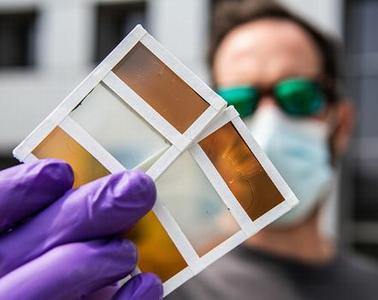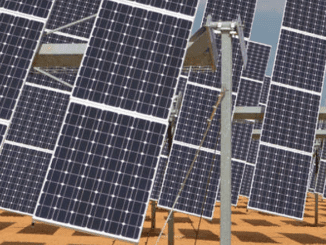
GOLDEN, Colorado, October 21, 2020 (ENS) – A thermochromic window that darkens automatically in the sun and simultaneously uses the sun to generate electricity has been invented by scientists at the chemistry and nanoscience center within the U.S. Dept. of Energy’s National Renewable Energy Laboratory, NREL.
Thermochromic glass uses heat from direct sunlight to tint glass. The more direct and intense sunlight is on thermochromic window glass, the darker it will become, reducing the heat and glare entering a building and increasing energy efficiency.
Residential and commercial buildings use 74 percent of all electricity and 39 percent of all energy in the United States, and the heat generated by sunlight shining through windows is the single largest contributor to the need for air conditioning and cooling in buildings.
Layered thermochromic glass has been on the market for commercial buildings since 2010, and extra-large windows using this material have been available from several manufacturers since 2015.

The NREL advance in this technology, termed “thermochromic photovoltaic,” allows a window to change color and at the same time function as a solar cell, generating power in place.
The NREL scientists embedded perovskites between the glass layers to generate electricity as a window transforms from transparent to tinted.
Crystalline structures that efficiently harness sunlight, perovskite crystals can be found in today’s ultrasound machines, memory chips, and now – solar cells.
Perovskite solar cells can be manufactured using simple, additive deposition techniques, like printing, for a fraction of the cost and energy of silicon solar cells. Because of the compositional flexibility of perovskites, they can also be tuned to ideally match the sun’s spectrum, explains the Clean Energy Institute at the University of Washington.
The NREL scientists sandwiched a thin perovskite film between two layers of glass and injected vapor. The vapor triggers a reaction that causes the perovskite to arrange itself into different shapes, from a chain to a sheet to a cube. The colors emerge with the changing shapes.
When light hits this transparent glass, it releases molecules of methylamine, which causes the glass to darken. As the glass darkens, electricity is generated. When the sun stops shining, the molecules are reabsorbed, and the glass becomes clear again.
Scientists have found they can design these flexible, tunable perovskite crystals with a wide variety of physical, optical, and electrical characteristics.
Perovskite thermochromic photovoltaic windows can turn whole buildings into energy generators, increasing their contribution to the needs of the entire energy grid.
NREL’s first-generation solar window could switch back and forth between transparent and a reddish-brown color and needed temperatures between 150 degrees and 175 degrees Fahrenheit to trigger the transformation. A later version allows a broader choice of colors and works at 95 degrees to 115 degrees Fahrenheit, a glass temperature easily achieved on a hot day.
NREL’s newest breakthrough enables myriad colors and a broader range of temperatures that drive the color switch. This increases the design options for improving energy efficiency and control over the building’s appearance that both architects and end-users want.
By using a different chemical composition and materials, the researchers also were able to rapidly speed up the color transformation. The time was reduced to about seven seconds from the three minutes it took during the proof-of-concept thermochromic photovoltaic window demonstrated in 2017.
“A prototype window using the technology could be developed within a year,” said Bryan Rosales, a postdoctoral researcher at NREL and lead author of the paper detailing this advance, entitled, “Reversible Multicolor Chromism in Layered Formamidinium Metal Halide Perovskites,” which appears in the October 16 issue of the journal “Nature Communications.”
His co-authors from NREL are Lance Wheeler, who developed the first thermochromic photovoltaic window, Taylor Allen, David Moore, Kevin Prince, Garry Rumbles, and Laura Schelhas.
Other authors are Laura Mundt from SLAC National Accelerator Laboratory, a U.S. Dept. of Energy National Laboratory operated by Stanford University, and Colin Wolden from the Colorado School of Mines.
Thermochromic windows are quickly growing in popularity and are being installed in many commercial, retail and residential buildings throughout the world, according to the Efficient Windows Collaborative, a U.S-based coalition of window, door, skylight, and component manufacturers, research groups, and government agencies at all levels.
To serve this new market for thermochromic windows, additional research is planned. Scientists want to know how many times a thermochromic window can be cycled into an electricity-generating operating mode and return to transparency. The efficiency of converting sunlight into electricity also will be explored.
This research is funded by the Building Technologies Office at the U.S. Department of Energy, DoE. NREL is the primary national laboratory for renewable energy and energy efficiency research and development. It is operated for the DoE by the Alliance for co-managed and governed by Battelle and MRIGlobal.
Copyright Environment News Service (ENS) 2020. All rights reserved.
© 2020, Environment News Service. All rights reserved. Content may be quoted only with proper attribution and a direct link to the original article. Full reproduction is prohibited.



